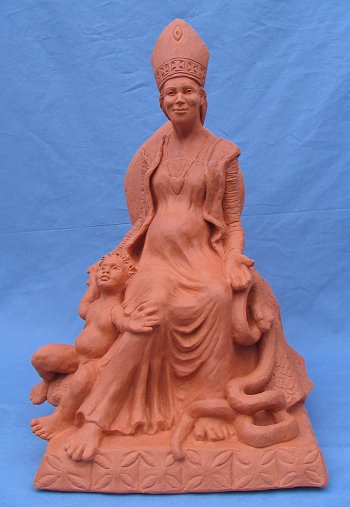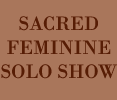
|
|
 |
About the Piece As with some of my other work, Pope Joan Revisioned tells a utopian story. It is the “what if? , the alternative ending to her life: she flourishes in an environment that grooms both men and women to be powerful spiritual leaders--Popes. Currently, Pope Joan’s history is controversial, with some regarding her as a myth and others as a documented historical figure. I have chosen to side step this debate, realizing that Pope Joan’s life holds truths and lessons in both its historical and mythical accounts. The fact that she is such a strong myth may speak to our desire for a female Pope. I am not illustrating history. Rather, I am giving voice to our desire for the balanced male and female in our lives. Judy Chicago (1996) details Pope Joan’s life in The Dinner Party: “A brilliant scholar, Joan disguised herself as a monk in order to study in Athens, where she obtained a degree in philosophy. She then went to Rome, where Pope Leo IV made her a cardinal; upon his death in 853, she was elected pope by her fellow cardinals. After two years, four months, and eight days as pope, she was discovered to be a woman when she gave birth to a baby, whereupon she and the child were stoned to death. She remained recognized as a pope until 1601, when Pope Clement VIII officially declared her to be mythical.” (p. 75) I have included an inscription on the back of Pope Joan’s throne that reads: “Pope Joan, her reign is one of peace and the fruit of her labor brings joy to the land”. The text is stated in the present tense to reinforce her timeless story. Pope Joan Revisioned becomes the historical Pope Joan, the mythical Pope Joan and the Pope Joan of the present and future. The child at Joan’s feet references the child that was historically stoned to death. I have revisioned her and that child as alive, and another child on the way. The cross that I have repeated along the base of the dais is similar to the cross mentioned by Dan Brown (2003) in his book The Da Vinci Code: “The head of this key was not the traditional long-stemmed Christian cross but rather was a square cross—with four arms of equal length—which predated Christianity by fifteen hundred years. This kind of cross carried none of the Christian connotations of crucifixion associated with the longer-stemmed Latin Cross, originated by Romans as a torture device. Langdon was always surprised how few Christians who gazed upon “the crucifix” realized their symbol’s violent history was reflected in its very name: “cross” and “crucifix” came from the Latin verb cruciare—to torture.” …equal-armed crosses like this one are considered peaceful crosses. Their square configurations make them impractical for use in crucifixion, and their balanced vertical and horizontal elements convey a natural union of male and female…” (p. 145). Barbara Walker (1998) also references a cross, shaped within a square, called a “cross Patee”, or “cross formee”. (p. 48) Carl Jung (1964) also differentiates between the Greek and Latin cross: “Up to Carolingian times, the equilateral or Greek cross was the usual form, and therefore the mandala was indirectly implied. But in the course of time the center moved upward until the cross took on the Latin form, with the stake and the crossbeam, that is customary today. This development is important because it corresponds to the inward development of Christianity to the high Middle Ages. In simple terms, it symbolized the tendency to remove the center of man and his faith from the earth and to “elevate” it into the spiritual sphere. This tendency springs from the desire to put into action Christ’s saying: “My kingdom is not of this world” Earthly life, the world, and the body were therefore forces that had to be overcome.” (p. 273) In the descriptions by Brown, Walker and Jung, the cross, a predominately male symbol, is described. Yet, the area surrounding the cross is regarded as the background, or the negative space, which serves to highlight the positive subject: the cross. This relationship between the cross and the surrounding space can be seen as a metaphor to describe the relationship between men and woman. Women have been cast as the background, the negative space, the invisible, the secondary, the discarded. Seeing the “invisible spaces” between the arms of the cross was an ah-ha experience for me. I had just finished Dan Brown’s The Da Vinci Code in March of 2004 and was sketching the templers cross, when in a lighting flash, instead of seeing the cross, I saw nestled between the arms of the cross, four yonis! I was overjoyed to see how these two powerful symbols, the cross and the yoni, defined each other and were dependent upon each other to shape the other's form. Therefore, I have modified the Templars cross, and have taken it in a different direction by highlighting the spaces between the arms of the cross: the yonis. Although my version of the cross is similar to the Templar’s cross, it is not one I have seen before. From here on in I will refer to this symbol as the Almond Cross, a name I have devised that acknowledges both the male and female forms. “Mandorla means “almond,” which was one of the more cryptic synonyms for this symbol, also known as vesica piscis, the Vessel of the Fish, and more simply as the yoni. Almonds are female-genital symbols and maternity charms from very ancient times. The virgin birth of the god Attis was conceived by a magic almond. Even the Israelites’ tabernacle made use of its fertility mana (Exodus 37:20), and Aaron’s rod produced almonds in token of a general power of fructification (Numbers 17:8).” (Walker, 1998, pg. 10). Recently, I was looking at a postcard of the Pope, as I was preparing to make the Pope Joan Revisioned, when I had the epiphany that the shape of the popes miter hat, and the face of the Pope combined, formed the almond shape: the yoni. To understand this relationship, envision a line that starts at the apex of the Popes Miter hat and curves down along the side of his face to the nadir of his chin, and then back up along the other side of his face to the starting point at the tip of the miter hat. This will outline an almond shaped yoni. The word yoni has come to connotatively represent for me the concept of a sacred space. This discovery was startling and reminded me of Leonard Shlain (1998), who documents that in overly patriarchical structures the feminine principle continues to surface in elements of the godhead despite monumental efforts to repress her. He notes: “As a general rule throughout Asia, the more patriarchal the society, the more the Buddha looks like a woman; the more egalitarian the society, the more the Buddha looks like a man. (p. 200) I would assume this is because in a more egalitarian society the female principle is allowed to express it self freely and does not need to be subverted and reassigned to the male. It is my hypothesis at this time, Summer 2004, that because the Catholic Church does not have balanced power between Yin and Yang, the Yin must subvert and express itself in one of the most potent and salient symbols of the Pope, his miter hat. Additionally, red is often associated with a woman’s menses. When I look at the Popes face, and red miter hat on top of his head, I am reminded of the sacred space of woman. I have also added a jewel to her miter hat to indicate her third eye, and clitoris. I have composed Pope Joan's throne from a curvaceous feminine yoni shape, and a geometric, masculine square shape. These shapes have an interplay between them and remind me of a variety of shapes: mosque-like onion domes and doorways, a phallus, a key hole. I define patriarchy as the cultural oppression of women, which is composed of both men and women. Perhaps, the most insidious propaganda of the patriarchy is to use women to perpetuate the continued suppression of other women. This way, the enemy becomes internalized and women continue the cycle of self hatred. An example of this is how Athena, Mary Magdalene, and the Virgin Mary are represented in sculptures crushing a serpent, representing female wisdom and and Goddess religions, beneath their feet. For this reason, I have shown Joan’s foot protruding from her robes, and a serpent, a symbol of female wisdom, crawling over her foot. Harmony and balance between the masculine and feminine is restored.
For questions or comments about Cydra's art, please email: womansculpture@icloud.com |


